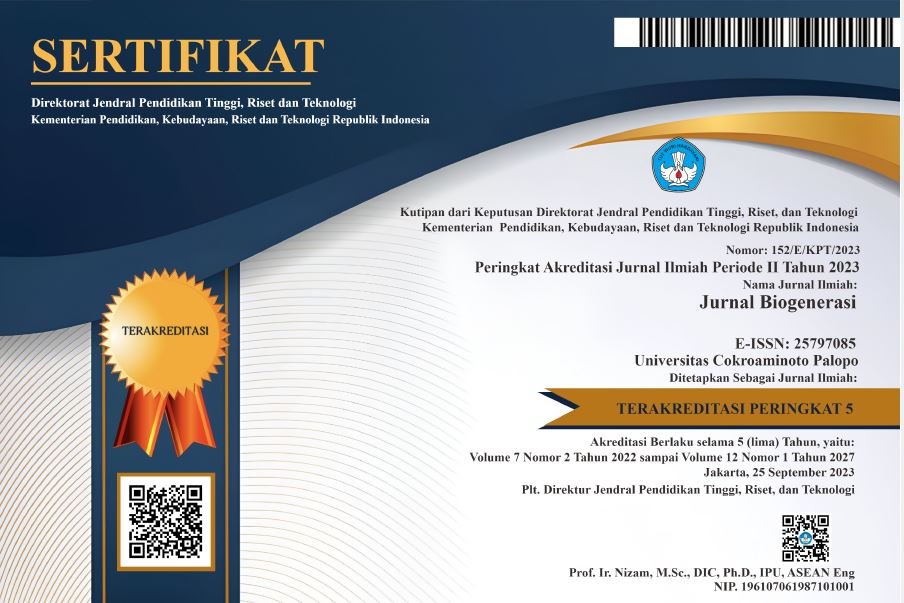PENGARUH MEDIA TANAM TERHADAP PERTUMBUHAN BAWANG MERAH (ALLIUM CEPA L.) MENGGUNAKAN HIDROPONIK SISTEM WICK
DOI:
https://doi.org/10.30605/biogenerasi.v10i2.5626Keywords:
Cocopeat, Husk, Hydroponic System Wick, Sand, OnionAbstract
Onion are one of the many types of shallots that exist in the world. Shallots are a member of the Allium genus which is usually used as a cooking spice. Demand for shallots will continue to increase along with people's needs that continue to increase. Hydroponics is a method of growing crops without using soil, usually using cocpeat, husks and sand as a substitute for soil. One hydroponic model that is easy to implement is the wick system method, where in this system the plants absorb water through the wick. The parameters observed were plant height, root length and number of tubers. The results of the research showed that the planting medium did not have a real influence on plant height and number of tubers, but on root length the planting medium had a real influence. The best planting medium for growing tall shallots is husk media: cocopeat (1:1) with the highest score of 27.90. Meanwhile, the root length and number of shallot bulbs were highest in the husk: sand (1:1) media with values of 16.00 and 6.22.
Downloads
References
Arini, W. (2019). Tingkat daya kapilaritas jenis sumbu pada hidroponik sistem wick terhadap tanaman cabai merah (Capsicum annum L.). Jurnal Perspektif Pendidikan, 13(1), 23-34.
Bahri, J. (2010). Kajian Pertumbuhan dan Hasil Bawang Merah (Allium ascalonicum L.) dengan Penambahan Arang Sekam dan Pemupukan Kalium. Skripsi. Universitas Muhammadiyah Purwokerto.
Binawati, K. D (2012). Pengaruh Media Tanam Terhadap Aklimatisasi Anggrek Bulan. Jurnal Wahana, 01, pp. 60-68
Dewi MK, & Sutrisna IK. (2016). Pengaruh tingkat produksi, harga dan konsumsi terhadap impor bawang merah di Indonesia. E-Jurnal Ekon Pembang Univ Udayana. 5(1):139–149.
Dodi, A., Seprido, S., & Pramana, A. (2018). Uji Perbandingan Arang Sekam Dengan Kompos Kulit Kakao Sebagai Media Tanam Terhadap Pertumbuhan Dan Produksi Bawang Merah (Allium ascalonicum. L) Hidroponik Sistem Wick. Jurnal Pertanian UMSB: Penelitian Dan Kajian Ilmiah Bidang Pertanian, 2(1).
Fahmi, Z. I. (2016). Medium Tanam sebagai Faktor Eksternal yang Mempengaruhi Pertumbuhan Tanaman. Buletin Balai Besar Pembenihan dan Proteksi Tanaman Perkebunan. Surabaya.
Hermansyah, A. (2013). Pengaruh pemberian pupuk kandang (kotoran sapi, kambing dan ayam) terhadap kemelimpahan Azotobacter sp dan pertumbuhan Kacang Tanah (Arachis hypogaea L.). Fakultas Sains dan Teknologi. Universitas Negeri Sunan Kalijaga. Yogyakarta.
Irawan, A., & Hidayah, H. N. (2014). Kesesuaian penggunaan cocopeat sebagai media sapih pada politube dalam pembibitan Cempaka (Magnollia elegans (Blume,) H.Keng). Balai Penelitian Kehutanan Manado, 1(2), 73-76.
Istina, I. N. (2016). Peningkatan produksi bawang merah melalui teknik pemupukan NPK. Jurnal Agro, 3(1), 36-42.
Komarudin, M. (2022). Sistem Pengendalian Kadar PH dan Penyiraman Tanaman Hidroponik Model Wick System. Jurnal Informatika dan Teknik Elektro Terapan, 10(1).
Margiwiyatno, A., & Sumarni, E. (2011). Modifikasi iklim mikro pada bawang merah hidroponik dalam rangka memperoleh bibit bermutu. Jurnal Keteknikan Pertanian, 25(1).
Milla, O. V., E. B. Rivera, W. J. Huang, C. C, Chien, & Y. M. Wang. (2013). Agronomic Properties And Characterization Of Rice Husk And Wood Biochars And Their Effect On The Growth Of Water Spinach In A Field Test. Journal of Soil Science and Plant Nutrition. 13(2):251-266.
Mulasari, S. A. (2018). Penerapan teknologi tepat guna (penanam hidroponik menggunakan media tanam) bagi masyarakat Sosrowijayan Yogyakarta. Jurnal Pemberdayaan: Publikasi Hasil Pengabdian Kepada Masyarakat, 2(3), 425-430.
Putra, H. K., Hardjoko, D., & Widijanto, H. (2013). Penggunaan pasir dan serat kayu Aren sebagai media tanam terong dan tomat dengan sistem hidroponik. Agrosains: Jurnal Penelitian Agronomi, 15(2), 36-40.
Pranata, E., (2018). Pengaruh Jenis Media Tanam Dan Pemberian Air Kelapa Terhadap Pertumbuhan Tanaman Sawi Pakcoy (Brassica rapa L.) Skripsi. Universitas Muhammadiyah Sumatera Utara, Medan
Pratiwi, N. E., B. H. Simanjuntak, & D. Banjarnahor. (2017). Pengaruh Campuran Media Tanam Terhadap Pertumbuhan Tanaman Stroberi (Fragaria Vesca L.) Sebagai Tanaman Hias Taman Vertikal. Agric. 29(1):11-20.
Risnawati, B. (2016). Pengaruh penambahan serbuk sabut kelapa (Cocopeat) pada media arang sekam terhadap pertumbuhan tanaman Sawi Hijau (Brassica juncea L.) secara hidroponik. Skripsi. Fakultas Sains dan Teknologi, Universitas Islam Negeri Alauddin. Makasar.
Simbolon, S. D. H., & Nur, M. (2018). Pengaruh kepekatan nutrisi dan berbagai media tanam pada pertumbuhan serta produksi bawang merah (Allium ascalonicum L) dengan hidroponik NFT. Dinamika Pertanian, 34(2), 175-184.
Siregar, M. (2020). Pengaruh aplikasi beberapa media tanam terhadap pertumbuhan dan produksi bawang merah dengan teknologi akuaponik. AGRIUM: Jurnal Ilmu Pertanian, 23(1), 46-51.
Sugianto, S., & Jayanti, K. D. (2021). Pengaruh komposisi media tanam terhadap pertumbuhan dan hasil bawang merah. Agrotechnology Research Journal, 5(1), 38-43.
Supriyadi, A., Sastrahidayat, I. R., & Djauhari, S. (2013). Kejadian penyakit pada tanaman bawang merah yang dibudidayakan secara vertikultur di Sidoarjo. Jurnal HPT (Hama Penyakit Tumbuhan), 1(3), 27-40.
Downloads
Published
How to Cite
Issue
Section
License
In submitting the manuscript to the journal, the authors certify that:
- They are authorized by their co-authors to enter into these arrangements.
- The work described has not been formally published before, except in the form of an abstract or as part of a published lecture, review, thesis, or overlay journal.
- That it is not under consideration for publication elsewhere,
- That its publication has been approved by all the author(s) and by the responsible authorities – tacitly or explicitly – of the institutes where the work has been carried out.
- They secure the right to reproduce any material that has already been published or copyrighted elsewhere.
- They agree to the following license and copyright agreement.
License and Copyright Agreement
Authors who publish with this journal agree to the following terms:
- Authors retain copyright and grant the journal right of first publication with the work simultaneously licensed under Creative Commons Attribution License (CC BY 4.0) that allows others to share the work with an acknowledgment of the work's authorship and initial publication in this journal.
- Authors are able to enter into separate, additional contractual arrangements for the non-exclusive distribution of the journal's published version of the work (e.g., post it to an institutional repository or publish it in a book), with an acknowledgment of its initial publication in this journal.
- Authors are permitted and encouraged to post their work online (e.g., in institutional repositories or on their website) prior to and during the submission process, as it can lead to productive exchanges, as well as earlier and greater citation of published work.


.png)

